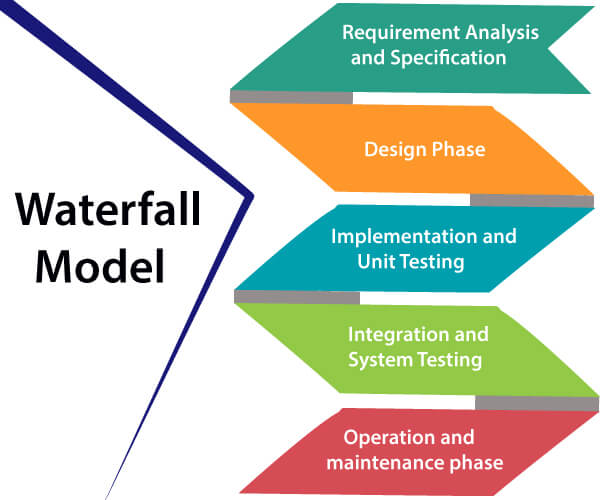Waterfall modelWinston Royce introduced the Waterfall Model in 1970.This model has five phases: Requirements analysis and specification, design, implementation, and unit testing, integration and system testing, and operation and maintenance. The steps always follow in this order and do not overlap. The developer must complete every phase before the next phase begins. This model is named "Waterfall Model", because its diagrammatic representation resembles a cascade of waterfalls. 1. Requirements analysis and specification phase: The aim of this phase is to understand the exact requirements of the customer and to document them properly. Both the customer and the software developer work together so as to document all the functions, performance, and interfacing requirement of the software. It describes the "what" of the system to be produced and not "how."In this phase, a large document called Software Requirement Specification (SRS) document is created which contained a detailed description of what the system will do in the common language. 
2. Design Phase: This phase aims to transform the requirements gathered in the SRS into a suitable form which permits further coding in a programming language. It defines the overall software architecture together with high level and detailed design. All this work is documented as a Software Design Document (SDD). 3. Implementation and unit testing: During this phase, design is implemented. If the SDD is complete, the implementation or coding phase proceeds smoothly, because all the information needed by software developers is contained in the SDD. During testing, the code is thoroughly examined and modified. Small modules are tested in isolation initially. After that these modules are tested by writing some overhead code to check the interaction between these modules and the flow of intermediate output. 4. Integration and System Testing: This phase is highly crucial as the quality of the end product is determined by the effectiveness of the testing carried out. The better output will lead to satisfied customers, lower maintenance costs, and accurate results. Unit testing determines the efficiency of individual modules. However, in this phase, the modules are tested for their interactions with each other and with the system. 5. Operation and maintenance phase: Maintenance is the task performed by every user once the software has been delivered to the customer, installed, and operational. When to use SDLC Waterfall Model?Some Circumstances where the use of the Waterfall model is most suited are:
Advantages of Waterfall model
Disadvantages of Waterfall model
Next TopicRAD Model
|
 For Videos Join Our Youtube Channel: Join Now
For Videos Join Our Youtube Channel: Join Now
Feedback
- Send your Feedback to [email protected]
Help Others, Please Share









